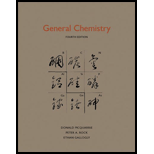
(a)
Interpretation:
Number of unpaired electrons and the neutral atom that is isoelectronic with
Concept Introduction:
Electrons of an atom are arranged in orbitals by the order of increasing energy. This arrangement is known as electronic configuration of atom. This can be represented using noble-gas shorthand notation also.
Ions are formed from neutral atom either by removal or addition of electrons from the valence shell.
Each orbital has two electrons and they both are in opposite spin. Electrons are filled up in the orbitals of a sub-shell by following Hund’s rule. This rule tells that all the orbitals are singly filled in a sub-shell and then the pairing occurs.
Isoelectronic species are the ones that have different number of protons but same number of electrons. No two neutral atom can be isoelectronic. A neutral atom can be isoelectronic with an ion.
(a)
Explanation of Solution
Given ion is
The given
According to Hund’s rule, the electrons are added to the orbitals only after singly filling all the orbitals. After this takes place only the pairing of electrons is done. Therefore, the expansion of orbitals in the outermost shell is given as shown below.
Therefore, there is one unpaired electron in
The total number of electrons present in
Total number of electrons that is present in
(b)
Interpretation:
Number of unpaired electrons and the neutral atom that is isoelectronic with
Concept Introduction:
Refer part (a).
(b)
Explanation of Solution
Given ion is
The given
According to Hund’s rule, the electrons are added to the orbitals only after singly filling all the orbitals. After this takes place only the pairing of electrons is done. Therefore, the expansion of orbitals in the outermost shell is given as shown below.
Therefore, there are no unpaired electrons in
The total number of electrons present in
Total number of electrons that is present in
(c)
Interpretation:
Number of unpaired electrons and the neutral atom that is isoelectronic with
Concept Introduction:
Refer part (a).
(c)
Explanation of Solution
Given ion is
The given
According to Hund’s rule, the electrons are added to the orbitals only after singly filling all the orbitals. After this takes place only the pairing of electrons is done. Therefore, the expansion of orbitals in the outermost shell is given as shown below.
Therefore, there are no unpaired electrons in
The total number of electrons present in
Total number of electrons that is present in
(d)
Interpretation:
Number of unpaired electrons and the neutral atom that is isoelectronic with
Concept Introduction:
Refer part (a).
(d)
Explanation of Solution
Given ion is
The given
According to Hund’s rule, the electrons are added to the orbitals only after singly filling all the orbitals. After this takes place only the pairing of electrons is done. Therefore, the expansion of orbitals in the outermost shell is given as shown below.
Therefore, there is one unpaired electrons in
The total number of electrons present in
Total number of electrons that is present in
Want to see more full solutions like this?
Chapter 5 Solutions
General Chemistry
- V Consider this step in a radical reaction: Br: ? What type of step is this? Check all that apply. Draw the products of the step on the right-hand side of the drawing area below. If more than one set of products is possible, draw any set. Also, draw the mechanism arrows on the left-hand side of the drawing area to show how this happens. ⚫ionization termination initialization neutralization none of the abc Explanation Check 80 Ο F3 F1 F2 2 F4 01 % do5 $ 94 #3 X 5 C MacBook Air 25 F5 F6 66 ©2025 ˇ F7 29 & 7 8arrow_forwardShow how to convert ethyl benzene to (a) 2,5-dichlorobenzoic acid and (b) 2,4-dichlorobenzoic acid.arrow_forwardno aiarrow_forward
- Polymers may be composed of thousands of monomers. Draw three repeat units (trimer) of the polymer formed in this reaction. Assume there are hydrogen atoms there are hydrogen atoms on the two ends of the trimer. Ignore inorganic byproducts.arrow_forwardDraw a tetramer if this alternating copolymer pleasearrow_forwardDraw the monomers required to synthesize this condensation polymer.arrow_forward
- Draw the monomers required to synthesize this condensation polymer.arrow_forward8:44 PM Sun Apr 13 Earn Freecash.com O Measurement and Matter =1 Setting up a unit conversion 110 Eddie says... ✰ www-awu.aleks.com A student sets up the following equation to convert a measurement. (The ? stands for a number the student is going to calculate.) Fill in the missing part of this equation. Note: your answer should be in the form of one or more fractions multiplied together. (- 4 J kJ -7.0 × 10 ☐ = ? mmol.°C mol °C x10 μ Explanation Check □·□ torox.io Grey Hill LLC. All Rightsarrow_forwardPolymers may be composed of thousands of monomers. Draw three repeat units (trimer) of the polymer formed in this reaction. Assume there are hydrogen atoms there are hydrogen atoms on the two ends of the trimer. Ignore inorganic byproducts please.arrow_forward
 ChemistryChemistryISBN:9781305957404Author:Steven S. Zumdahl, Susan A. Zumdahl, Donald J. DeCostePublisher:Cengage Learning
ChemistryChemistryISBN:9781305957404Author:Steven S. Zumdahl, Susan A. Zumdahl, Donald J. DeCostePublisher:Cengage Learning ChemistryChemistryISBN:9781259911156Author:Raymond Chang Dr., Jason Overby ProfessorPublisher:McGraw-Hill Education
ChemistryChemistryISBN:9781259911156Author:Raymond Chang Dr., Jason Overby ProfessorPublisher:McGraw-Hill Education Principles of Instrumental AnalysisChemistryISBN:9781305577213Author:Douglas A. Skoog, F. James Holler, Stanley R. CrouchPublisher:Cengage Learning
Principles of Instrumental AnalysisChemistryISBN:9781305577213Author:Douglas A. Skoog, F. James Holler, Stanley R. CrouchPublisher:Cengage Learning Organic ChemistryChemistryISBN:9780078021558Author:Janice Gorzynski Smith Dr.Publisher:McGraw-Hill Education
Organic ChemistryChemistryISBN:9780078021558Author:Janice Gorzynski Smith Dr.Publisher:McGraw-Hill Education Chemistry: Principles and ReactionsChemistryISBN:9781305079373Author:William L. Masterton, Cecile N. HurleyPublisher:Cengage Learning
Chemistry: Principles and ReactionsChemistryISBN:9781305079373Author:William L. Masterton, Cecile N. HurleyPublisher:Cengage Learning Elementary Principles of Chemical Processes, Bind...ChemistryISBN:9781118431221Author:Richard M. Felder, Ronald W. Rousseau, Lisa G. BullardPublisher:WILEY
Elementary Principles of Chemical Processes, Bind...ChemistryISBN:9781118431221Author:Richard M. Felder, Ronald W. Rousseau, Lisa G. BullardPublisher:WILEY





